Telehealth Now available
bulkbilled through medicare and DVA where applicable *
bulkbilled through medicare and DVA where applicable *
At Cheltenham Podiatry, knee pain is a common presenting
problem. We assess the area mechanically, view the
surrounding joint structures on ultrasound and may request
further diagnostics – x-rays, MRI, etc. to ensure an
appropriate treatment plan is created.
Symptoms
Symptoms of a knee condition vary greatly and depend on
the underlying cause. In association with general pain and
discomfort around the joint, the following symptoms can
occur.
Decreased range of motion
Swelling
Redness
Instability
Giving way, clicking, and popping noises
An inability to straighten your knee or locking
Causes of knee pain
There are many conditions that can cause dysfunction and
knee pain. The most common conditions we see are listed
below:
Ligament Strains and Sprains (MCL, LCL)
Meniscal tears
Tendonitis or tendinosis
Bakers’ cysts
Osteoarthritis and degenerative joint disease
Iliotibial band syndrome
Patellofemoral Instability
ACL and PCL injuries
Diagnosis
We asses your knee, and do an ultrasound exam, and may
require further diagnostic scans if you haven’t already done
them.
Treating your knee pain
Treatment of the knee concern will depend on the
conditions.
Rehabilitation is an important part of treating many knee
conditions. Injection therapy can also speed recovery. Other
modalities can be added where rehabilitation fails or is not
providing sufficient improvements in function and pain
reduction. This includes injection therapy, laser, and
shockwave therapy.
The standard injection treatment for degenerative joint
disease of the knee is to offer steroid or cortisone
injections. This is despite medical literature confirming that
there are significant side effects to ongoing steroid or
cortisone injections, including progression of the
degeneration of the joint. Cheltenham Podiatry’s philosophy
is to provide minimal invasive techniques that restore
function and reduce pain naturally. Instead of cortisone and
steroid injections, we use precise, image guided injection
Platelet Rich Plasma (PrP) or Prolotherapy which are
anabolic (growth encouraging) unlike cortisone which is
catabolic (to break down).
We combine these therapies with rehabilitation, and where
appropriate, laser and/or shockwave, for more efficient
outcomes.
Common causes of knee pain
• Symptoms: The most common symptoms are kneecap
pain, knee swelling and pain on stairs, especially on the
way down. Runners Knee usually settles within a few
months.
• Treatment: One of the most effective treatments for
Runners Knee is exercises to strengthen and stretch the
knee muscles. Other things that can help include ice,
knee braces and orthotics, and laser.
2.Iliotibial Band Syndrome aka ITBS
ITBS is the most common of the causes of knee pain on
the outer side of the joint and is often seen in runners. The
iliotibial band runs down the outer side of the thigh attaching
at the knee.
• Causes: Ilitibial band syndrome usually develops due
to excessive friction on the IT band, caused by things
such as muscle imbalance, excessive running, or running
on a slope and incorrect training methods resulting in
inflammation.
• Symptoms: ITBS typically results in pain on the outer
side of the knee that gets worse with activities such as
running and going down steps. There may be a funny
snapping sensation as you bend your knee and some
swelling.
• Treatment: Rest from aggravating activities is
important with ITBS and should be combined with
tailored strengthening and stretching exercises. Wearing
a knee strap can make a big difference along with
orthotics, shockwave, laser.
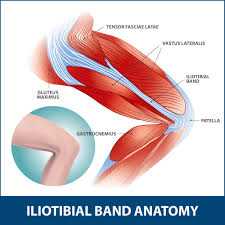
3.Chondromalacia Patella
Chondromalacia Patella is one of the most common causes
of knee problems in sporty adolescents and young adults,
especially females.
• Causes: Chondromalacia patella is caused by damage
to the cartilage that lines the back of the kneecap usually
due to a combination of muscle imbalance, altered
biomechanics and overuse
• Symptoms: It results in pain at the front of the knee,
especially when going downstairs, or after sitting for long
periods, and can cause the knee to make funny noises
when it moves.
• Treatment: Exercises, laser, knee straps, orthotics,
appropriate footwear, and activity modification are the
usual treatment options for chondromalacia.
4.Osgood Schlatter’s Disease
Osgood Schlatter Disease is one of the most common
causes of knee pain in teenagers, especially males.
• Causes: Osgood Schlatter’s usually develops after a
growth spurt due to the bones growing faster than the
muscles, causing friction. This can lead to a bony lump
forming just below the patella.
• Symptoms: There is usually pain below the kneecap,
worse with activity, better with rest. Tenderness and
swelling over the shin bone are common.
• Treatment: A combination of RICE, laser exercises,
knee straps and knee pads.
• Recovery: This is one of the longer lasting causes of
knee pain and it can take anywhere from a few weeks to
2 years to settle
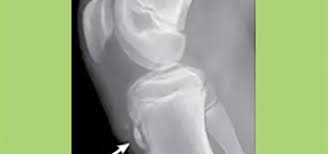
5.Knee Arthritis
Knee Arthritis is the most common of the causes of knee
pain in people over the age of 50.
• Causes: Knee Arthritis is caused by wear and tear to
the cartilage that lines the joint, leading to bone-on-bone
contact. It is more common in women and in those who
have previously injured their knee or had knee surgery.
• Symptoms: Arthritis in the knee can cause pain,
swelling, weakness, limited movement, and difficulty with
everyday activities such as walking and going up and
down stairs. Symptoms of knee arthritis tend to get
progressively worse over time.
• Treatment: Knee Arthritis treatment varies according to
the severity of the disease. Common treatments for
arthritis include exercises, knee braces, laser,
shockwave, and injection therapy such as prolotherapy
or PrP.
6.Bursitis of the Knee
Knee bursitis is caused by inflammation of a bursa – small
fluid-filled sacs that lie between bones and muscles/tendons
to prevent irritation. There are approximately 15 bursae
around the knee.
• Causes: Excessive friction between tissue layers, from
activities such as jumping, running, or muscle tightness
can lead to swelling of one or more bursa which leads to
pain.
• Symptoms: The location of the pain will depend on
which bursa is affected. The symptoms tend to be
general pain and swelling around the knee.
• Treatment: Rest from aggravating activities is vital
when bursitis causes knee pain. A combination of
strengthening and stretching exercises, and laser can be
used.
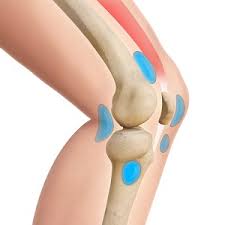
7.Bakers Cyst
A Bakers Cyst, aka Popliteal Bursitis, is the accumulation of
joint fluid at the back of the knee joint. It is one of the most
common causes of knee pain at the back of the knee.
• Causes: It is usually caused by fluid associated with
arthritis or a cartilage tear, leaking into the bursa and
causing it to swell, but it can occur after any damage to
the knee.
• Symptoms: The symptoms of a Bakers Cyst knee tend
to be pain and swelling behind the knee, like a soft
orange which can limit knee movement.
• Treatment: Treatment options include ice, injections to
aspirate/drain the excess fluid and then infiltrate pop or
prolotherapy to reduce pain and swelling, combined with
exercises.
8.Pre patella bursitis
Usually affects tradesmen such as roofers and carpet layers
who spend long periods kneeling who suffer from this
common cause of front knee pain and swelling.
• Causes: Excessive kneeling, or less commonly, a
knock to the front of the knee causes swelling in the
prepatellar bursa
• Symptoms: The most common symptoms of are pain
at the front of the knee, swelling and difficulty walking,
bending the knee and kneeling.
• Treatment: As with other knee bursitis a combination of
rest, ice, laser, injections, and exercises tends to be most
effective.
9.Pes Anserine Bursitis
Pes Anserine Bursitis is one of the causes of knee pain on
the inner side of the knee slightly below the joint, caused by
inflammation of the pes anserinus bursa.
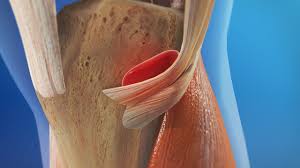
• Causes: Repetitive friction from activities such as
swimming and running irritates the pes anserine knee
bursa. People with other medical conditions such as
arthritis and type 2 diabetes, along with obese middle-
aged women are the most likely to be affected.
• Symptoms: Pain in the inner side of the knee 2-3
inches below the joint in the most defining symptom of
pes anserine bursitis. Sleep is often disturbed and there
may be weakness and stiffness in the knee.
• Treatment: As with most causes of knee pain,
exercises are one of the most important treatment
options here. They should be used carefully to allow rest
from any aggravating activities. Laser, and injections –
PrP or prolotherapy can also be used.
10.Gout in the Knee
Gout is a type of arthritis and is one of the causes of knee
pain that can affect other areas as well, such as the hands
and feet. High levels of urate crystals form in the joint
causing intense knee pain and inflammation.
• Causes: Common causes of gout include diet, obesity,
genetics.
• Symptoms: Gout sufferers typically present with a hot,
swollen, red knee which usually develops at night and
can be extremely painful.
• Treatment: Medication is one of the best treatments for
inflammatory causes of knee pain and gout is no
exception. Rest and ice can also help.
11.Jumpers Knee aka Patellar Tendonitis
Jumpers Knee is one of the common causes of knee pain
affecting sports players caused by damage to the tendon
just below the kneecap.
• Causes: Repetitive jumping and/or kicking can lead to
Jumpers Knee as these activities place lots of strain on
the patellar tendon and can lead to small tears in the
tendon. This weakens the tendon and makes it prone to
further damage.
• Symptoms: The most common symptoms of patellar
tendonitis include pain just below the kneecap, especially
after prolonged periods of rest and/or activity as well as
knee stiffness first thing in the morning.
• Treatment: Rest from any activities that are causes of
knee pain here, exercises and in some cases surgery.
Many people find wearing a knee strap really helps as it
takes the tension off the patella tendon. Rehabilitation,
laser, and PrP injections can be used.
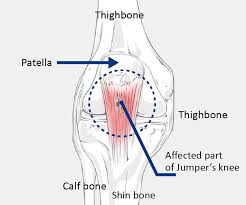
12.Quadriceps Tendonitis
Quadriceps Tendonitis is a common cause of activity-related
pain at the front of the knee.
• Causes: Sports involving lots of jumping, sprinting or
quick turns, over-training, and muscle imbalance place
excess force through the tendon above the kneecap,
resulting in small tears.
• Symptoms: Pain just above the kneecap that gets
worse with activity, knee swelling and stiffness and
kneecap tenderness.
• Treatment: Rest from aggravating activities, knee
strap, strengthening & stretching exercises, ice, friction
massage, shockwave, injections, and laser.
13.Osteochondritis Dissecans
Osetochondritis Dissecans is one of the less
common causes of knee pain. A reduced blood supply to
parts of the bone causes loose fragments of cartilage and
bone to break off. Whilst it can occur in any joint, it is the
knee that is the most affected.
• Causes: Repetitive minor damage to the joint from
activities such as jumping and kicking can lead to
osteochondritis at the knee. There is also thought to be
a genetic link.
• Symptoms: As well as knee pain, it can cause locking
and clunking sensations in the knee, limited movement
and swelling.
• Treatment: Non-surgical treatment including rest,
physical therapy, and the use of knee braces. In some
cases, surgery is necessary.
14.Bipartite Patella
Bipartite patella is a knee condition that often goes
unnoticed until you overwork or injure the knee making it
one of the rarer causes of knee pain.
• Causes: Incomplete formation of the kneecap – the
bone fails to fuse together fully during childhood leaving
the kneecap in two pieces.
• Symptoms: Pain at the front of the knee, tender to
touch, feels like the knee will give way and you may be
able to feel a slight ridge on the kneecap. Many people
with bipartite patella go through life never knowing they
have it as it often doesn’t cause any pain at all.
• Treatment: Rest from aggravating activities,
strengthening and stretching exercises, knee braces and
occasionally surgery to join the bony fragments.
• Recovery: Symptoms of bipartite patella usually settle
within two to three months.
15. Plica Syndrome
Plica syndrome is a cause of knee pain that often goes
undiagnosed as its symptoms mimic other knee problems. It
is caused by inflammation of the membrane that lines the
knee joint.
• Causes: Blow to the front of the knee, repetitive knee
bending e.g., cycling or stairs, sudden increase in activity
levels, knee injury and muscle weakness.
• Symptoms: Dull, achy knee pain that gets worse with
activity, instability, knee clicking, locked knee, restricted
movement.
• Treatment: Rest from aggravating activities, stretches,
strengthening exercises, physical therapy, steroid
injections, or surgery.
If you have unresolved knee pain, please make an
appointment now.
Talar Fractures at ankle Classification system The talus is a bone[…]